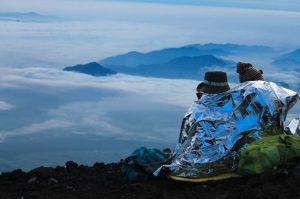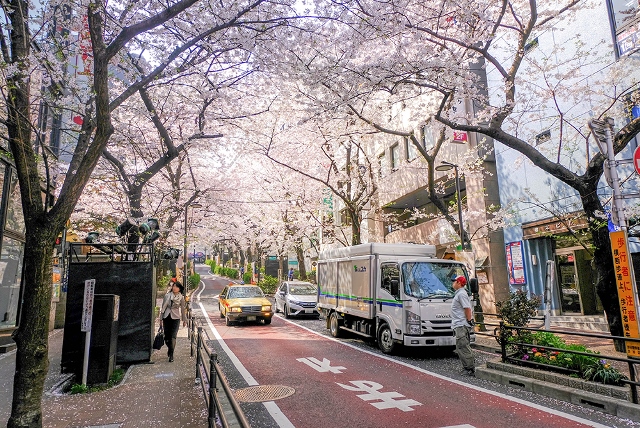FUJI-SAN. Ascent to the most famous mountain in Japan (part 1)
 The view from the top of Mount Fuji to the clouds floating at the feet is one of the most cherished spectacles that every tourist probably dreams of when he is in the Land of the Rising Sun. But climbing to a height of 3,766 meters is not a walk in the park at all. And if you still decided that the climb to Fuji is exactly what you need, you should remember a few simple things to make this event truly unforgettable.
The view from the top of Mount Fuji to the clouds floating at the feet is one of the most cherished spectacles that every tourist probably dreams of when he is in the Land of the Rising Sun. But climbing to a height of 3,766 meters is not a walk in the park at all. And if you still decided that the climb to Fuji is exactly what you need, you should remember a few simple things to make this event truly unforgettable.
You can climb 4 different paths to the top of Fuji; there is also a circular route that goes through the 5th Fuji station. Which way is better? All routes have their pros and cons. We recommend choosing the Yoshida trail, which is considered the most popular.This is the most successful route, especially if you go at night and want to meet the sunrise on Fuji. It is also the oldest trail along which pilgrims climbed to the top more than 500 years ago.
In any case, no matter which route you choose, before ascending it will be useful to check the official website to see if it is fully open and what weather conditions await you.
The first thing you should ask yourself before going up to Fuji is whether you can go so long without the opportunity to lie down to rest. It is enough to estimate the distance and imagine the way to understand that this is not an idle question.
How long does it take to climb Fuji? 4 to 8 hours. It all depends on how fast you walk, how long you can maintain the pace of walking, and how crowded on the trail.
If 8 hours on the road sounds intimidating, you can reserve a place in one of the gatehouses where tourists rest during the ascent. But keep in mind that you will be in a tiny room along with 20-40 other tourists. Ever wanted to feel like sardines in a jar? A very similar feeling. But if you are determined to conquer Fuji and can not do without rest, curl up for a while – is also a way to relax in order to reach.
WHEN IS THE FUJI MOUNTAIN SEASON OPENED?
Routes are usually open from early July until mid-September. The following dates were announced this year:
Yoshida trail: July 1 – September 10, the descent is open until the morning of September 11.
Fujinomiya, Gotemba and Subashiri routes: July 10 – September 10.
Ohati-Maguri Trail (near the edge of the crater): July 10 – September 10.
Professional advice: Before making a trip plan, it is worth checking that the tracks will be open on the days when you want to make the climb.
What day is better to climb?
Especially crowded during school holidays, in Japan it is the period from mid-July to the end of August and during the celebration of Obon, in mid-August. There are also more people on weekends than on weekdays.
What time of day to choose for climbing Fuji?
If you are indifferent to sunrises and sunsets, you are more fortunate than others. Just plan your climb between these phenomena, and it will go very calmly.
Otherwise, check the forecast and the exact time when sunset or dawn is expected, and hit the road 5-10 hours before. Just honestly evaluate your strength. If you are not an athlete and not half a person half a gazelle, it is better to take more time to climb.
Photo: Hajime Nakano
What do you need during the climb?
Warm clothes. Even in the middle of summer it gets very cold closer to the top. Therefore, take at least a few warm clothes and something waterproof in case of rain. And do not buy cheap thermal blankets in combination near the house, they will not save from the cold.
Headlamp. Of course, an ordinary flashlight will also work if you do not want unnecessary expenses. But the headlamp will free your hands, and all the way you will feel like a participant in this adventure.
Snacks Take something light and high in calories, like chocolate or dried fruit snacks. It all depends on how much weight you are ready to bear.
Water. Plenty of water! Do not save on water, otherwise you can earn a serious headache from dehydration. Of course, there will be several places along the way where you can buy water or have a snack. Fuji has restaurants, shops, and vending machines. At the top there are a couple of shops and a small restaurant, as well as the largest vending machine in Japan and possibly the world.
Cash. Take money just in case if you want to eat and drink. You may also be offered to make a small donation to maintain the condition of the trail (not more than 1000 yen).
A small backpack. Remember that for more than five hours you stomp uphill with a backpack, so take one that does not press, which is convenient and not annoying.
What awaits you during the ascent?
Crowds of people. Even if you go in calm time, that is, on a weekday, climbing Mount Fuji will still seem like a crowded hike. And if you dare to go to the peak of the season, then you will immediately realize that neither rock climbing, nor hiking, nor even walking with a sports step shines for you. Climbing to Fuji these days turns into endless waiting in line and a very slow progress.




